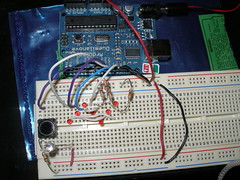Project: Dice
I ran across this project for a single 6-sided die at the Electronics Club website and I was intrigued by their use of a grouped logic for presenting the results. I wanted to use my Duemilanova for both the randomizer and the LED driver though. Here are my results.The first step was to set up the breadboard circuit. I'm using a solderless breadboard so I ended up with the seven pips on a diagonal.

The logic of the circuit is this: every time an odd number is rolled on a die, the center pip is included. Every number other than one has pairs of pips showing, with or without the center.
So the center has a pin to itself (13), and the other pips are paired by the white jumpers. Each pair gets a pin, which allows me to represent 6 (actually 7) numbers using 4 pins -- and no decoder.
My first sketch computes a random number (using pin 0 as a seed as suggested in the randomize() documentation) from 1 to 6, turns on the appropriate pips, waits a second, then does it again.
Here's video:
And here's the sketch:
/*
Die
computes a random number from 1 to 6 and displays it using 7 LEDs as a die face
The circuit:
* LED connected from digital pin 13 to ground.
* 2 LEDs in serial connected from digital pin 12 to ground. (2s place)
* 2 LEDs in serial connected from digital pin 11 to ground. (4s place)
* 2 LEDs in serial connected from digital pin 10 to ground. (6s place)
Created 26 Dec 2009
By Anne Speck
*/
int die1; // container for current value of die1 (possible future expansion)
int basket; // variable for processing die values
int ledPin13 = 13; // LED connected to digital pin 13
int ledPin12 = 12; // 2 LEDs connected to digital pin 12
int ledPin11 = 11; // 2 LEDs connected to digital pin 11
int ledPin10 = 10; // 2 LEDs connected to digital pin 10
int one = LOW;
int two = LOW;
int four = LOW;
int six =LOW;
// The setup() method runs once, when the sketch starts
void setup() {
// initialize the digital pin as an output:
pinMode(ledPin13, OUTPUT);
pinMode(ledPin12, OUTPUT);
pinMode(ledPin11, OUTPUT);
pinMode(ledPin10, OUTPUT);
//use serial output for debugging
Serial.begin(9600);
}
// the loop() method runs over and over again,
// as long as the Arduino has power
void loop()
{
// generate random number
// if analog input pin 0 is unconnected, random analog
// noise will cause the call to randomSeed() to generate
// different seed numbers each time the sketch runs.
// randomSeed() will then shuffle the random function.
randomSeed(analogRead(0));
die1 = random(1, 7);
// translate number into pins for display
basket = die1;
if (basket%2) {
//If there's a modulo, this is an odd number.
basket--;
one=HIGH;
}
if (basket == 6) {
//If six, turn on sixes place and subtract two
basket--;
basket--;
six=HIGH;
}
if (basket == 4) {
//If four, turn on fours place and subtract two
basket--;
basket--;
four=HIGH;
}
if (basket == 2) {
//If this has a value it's two.
basket=0;
two=HIGH;
}
digitalWrite(ledPin13, one); // set the LED on
digitalWrite(ledPin12, two); // set the LED on
digitalWrite(ledPin11, four); // set the LED on
digitalWrite(ledPin10, six); // set the LED on
//serial output for debugging
Serial.print("The number is: ");
Serial.println(die1);
Serial.print(one);
Serial.print(two);
Serial.print(four);
Serial.println(six);
delay(1000); // wait for a second
//Reset all pins
one = LOW;
two = LOW;
four = LOW;
six =LOW;
}

0 Comments:
Post a Comment
Subscribe to Post Comments [Atom]
<< Home